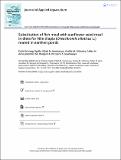| dc.contributor.author | rick Ochieng Ogello, Elijah M Kembenya, Cecilia M Githukia, Callen N Aera, Jonathan M Munguti, Chrispine S Nyamweya | |
| dc.date.accessioned | 2020-08-21T08:44:31Z | |
| dc.date.available | 2020-08-21T08:44:31Z | |
| dc.date.issued | 2017-01-02 | |
| dc.identifier.citation | 10 | en_US |
| dc.identifier.issn | 1045-4438 (Print) 1545-0805 (Online) | |
| dc.identifier.uri | https://repository.maseno.ac.ke/handle/123456789/2262 | |
| dc.description | Journal homepage: https://www.tandfonline.com/loi/wjaa20 | en_US |
| dc.description.abstract | This study investigated sunflower seed meal (SSM) as dietary protein replacement of fish meal (FM) for Nile tilapia (Oreochromis niloticus) juveniles (initial mean weight of 19.8 ± 6.3 g) reared in earthen ponds for 210 days. SSM replaced 25%, 50%, 75%, and 100% (i.e., D25, D50, D75, and D100, respectively) of FM in an isonitrogenous and isocaloric diet. The optimum FM replacement level of D25 as predicted by the equation y = 177.5 + 26.5x – 7.9x2 yielded an optimum weight of about 184 g within 100 days. Thus D25 was the most effective SSM level for Nile tilapia growth in earthen ponds. Fish growth declined as SSM exceeded D25. The length-weight relationship (r ≥ 90%) depicted an isometric fish growth. Nutrient utilization parameters were similar in all the diets except for D100. The protein content of fish carcass was highest in the control and D25, while fiber level was highest in D100. Amino acids imbalance and high fiber content could have reduced the fish growth at D50, D75, and D100. | en_US |
| dc.publisher | Taylor & Francis | en_US |
| dc.subject | Aquaculture, fishmeal, isocaloric diet, isonitrogenous diet, sunflower seed meal | en_US |
| dc.title | Substitution of fish meal with sunflower seed meal in diets for Nile tilapia (Oreochromis niloticus L.) reared in earthen ponds | en_US |
| dc.type | Article | en_US |

